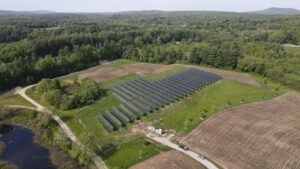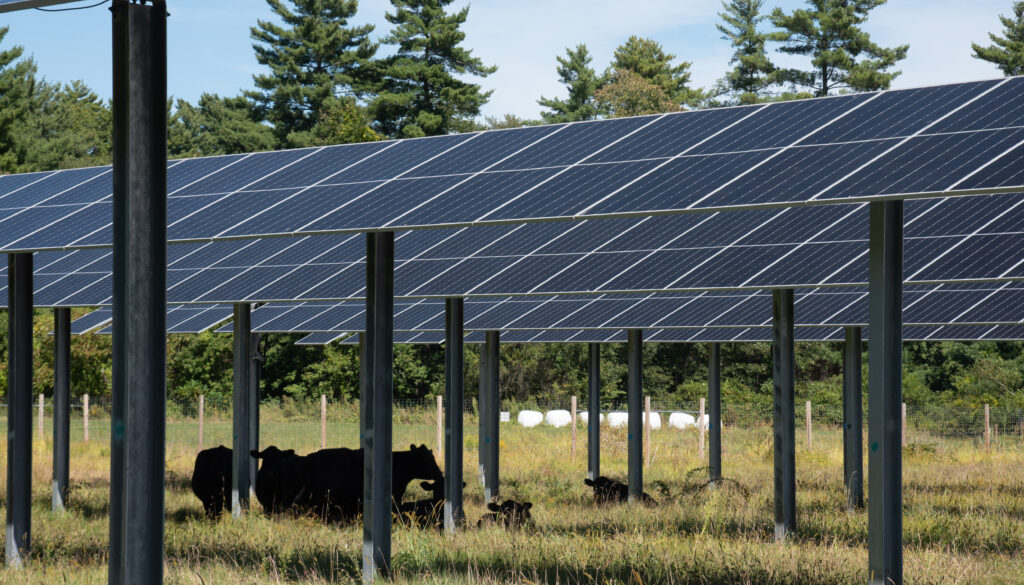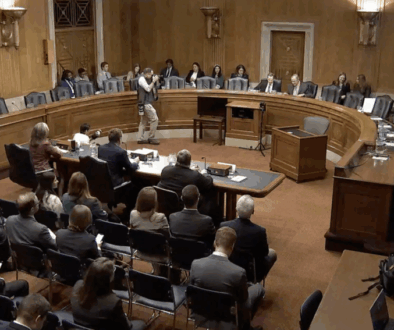Listen to the audio version of this article (generated by AI).
PALMER, Mass. — On a recent hot autumn day, a dozen black cows took respite in the shade cast by a 10-foot-tall series of solar panels set above 13 acres of hayfields at Burgundy Brook Farm.
Farm owner Tom Roberts grazes cattle and grows timothy and other forage grasses beneath the solar array. Roberts receives rent from the developer and owner of the solar project, but doesn’t tap into the solar energy produced by the two-megawatt (MW) system, himself. Half of the electricity generated by the panels on his family’s property is sold through renewable energy credits to roughly 175 low-income homes while a hospital buys the other half.
“The cash flow keeps the farm progressing in the right direction,” said Roberts, whose western Massachusetts farm spans more than 400 acres.

The community solar system on Roberts’ farm is one of 20,691 solar arrays, both residential and commercial, now operating in Massachusetts, where policy makers have established the Solar Massachusetts Renewable Target, (SMART) program to encourage solar expansion. Through the program, the state compensates homeowners and businesses for producing solar electricity.
Massachusetts has recently revamped and expanded incentives under the SMART program, now dubbed SMART 3.0, to keep the solar market growing even in the face of moves by the Trump administration discouraging solar and other renewable energy expansion. The state said it will be accepting applications for new SMART projects starting Oct. 15.
State leaders have vowed to invest $1 billion over 10 years in new technologies to mitigate harmful climate change. Massachusetts additionally passed legislation at the end of last year to promote non-gas heating, expand access to electric vehicles, tackle rising energy costs, and other measures favoring renewable energy growth.
Massachusetts is one of many states nationwide with programs that encourage renewable energy development to meet robust greenhouse gas reduction goals. And like Massachusetts, many other states are sharpening their clean energy strategies to navigate the anti-renewable energy policies of the Trump administration.
In just the first several months since taking office, Trump’s White House has moved to cancel billions of dollars allotted to clean energy projects, frozen permitting for wind projects and gutted vital federal tax credits incentivizing renewable energy projects. The federal tax credits – a tool often used to spur development of new technologies – have been instrumental in reducing the upfront costs of building new clean energy projects.
An analysis by Rhodium Group, an independent research provider, estimated that under a worst-case or high-emissions scenario, clean energy deployment would be half what was expected under the Biden administration through 2035.
“States are recognizing … we need to step up and fill this void of leadership to make sure that we’re meeting energy demand and doing so in a way that’s environmentally responsible but moreover more affordable,” said Jacob Weinberg, a spokesman for the Solar Energy Industries Association.
“Hungry for solutions”
Electricity prices are rising at more than double the rate of inflation, and prices are only forecast to keep climbing as power-sucking new technologies leave states “hungry for solutions”, according to Kelly Trombley, senior director of state policy at the nonprofit Ceres, which works with businesses to advocate for clean energy policies.
“State governments recognize the political liability of high energy prices, and they also see the projected loads coming from not just data centers, but increased manufacturing and [vehicle] electrification,” she said.
The Trump administration has said it sees US coal plants as a partial solution, recently announcing $625 million in investments to reinvigorate and expand the US coal industry. But many state leaders are not in agreement, and neither are energy analysts.
The governors of Arizona and North Carolina have each issued recent executive orders creating task forces to determine how their states will keep utility costs affordable, maintain clean energy leadership, and meet economic development and environmental goals.
California, meanwhile, passed a six-bill package addressing affordability, including authorizing the state to participate in a regional western energy market and public financing for transmission infrastructure, as well as for expediting renewable energy on to the grid.
“State governments recognize the political liability of high energy prices, and they also see the projected loads coming from not just data centers, but increased manufacturing and [vehicle] electrification.” – Kelly Trombley, Ceres
Nevada Gov. Joe Lombardo, a Republican, wrote to US Department of Interior (DOI) Secretary Doug Burgum in August expressing concern that federal policies were preventing or delaying major solar energy projects.
The governors’ office has since had “productive discussions” with DOI officials, “and it is clear that the administration is attentive to Nevada’s commitment” to advancing these projects, said John Meny, the governor’s press secretary.
“If you want new power resources, renewables are the answer. They are also the most cost-effective,” Dennis Wamsted, energy analyst at the Institute for Energy Economics and Financial Analysis, said. Investment bank Lazard released a report in June which found that unsubsidized wind and solar are the lowest cost sources of energy generation.
“Solar and wind are still going to get built because you can’t build anything else right now,” he continued, noting there’s a five to seven year wait for natural gas turbines because of manufacturing bottlenecks.
“What reality looks like”
For the first half of 2025, solar and battery storage accounted for 82% of all new power generation added to the grid, as developers raced to qualify for tax credits before they expire on December 31. While battery storage devices do not generate their own energy, they amplify wind and solar energy by storing it and releasing it later, including when the sun isn’t shining or the wind isn’t blowing.
Solar developer BlueWave, which installed the solar system on the Burgundy Brook Farm, owns and operates nine solar arrays on a variety of vegetable, fruit, hay and livestock farms in the Northeast. Through the “dual-use” systems, farmers can continue to grow crops and graze livestock on land where elevated solar panels work to generate power.
Dual use solar provides additional benefits Roberts said he wasn’t anticipating. “By giving the hay crop underneath it some periodic shade throughout the day, we’ve seen an increase in the quality and the quantity of the grass, because it doesn’t seem to get burned out as quick by the hot sun,” he said.
BlueWave plans to build 10 to 20 more in the state over the next few years.
Last year, the company projected to build 60 such systems across the Northeast and Illinois, but now is hesitant to forecast how many will move forward.
“We’re still trying to figure out what reality looks like from here on out,” said Gabrielle Hayes, sustainable solar development manager at BlueWave.

The Burgundy Brook Farm solar array took five years to become operational, largely because of the wait for grid connection, Hayes said. Insufficient transmission capacity often leads to delays that also drive up soft costs.
While new transmission systems are costly and take a long time to build, new technologies—like high performance conductors—can greatly expand the existing capacity of transmissions systems, and therefore hasten clean energy deployment, according to Trombley.
“That’s helpful, because we have all of this clean energy waiting in the interconnection queue,” she said. State legislation requiring utilities to evaluate the costs and benefits of grid enhancement technologies was a “big trend this year that we fully expect to see this coming year,” she added.
New Mexico, Oregon, South Carolina, Virginia and Massachusetts were among states passing such legislation in the past year.
Similarly, battery storage can expand clean energy transmission by storing solar and wind energy and releasing it when the power is most needed.
Federal tax credits, albeit reduced, will remain for storage for another 10 years, and states are moving to take advantage of them. This year, Massachusetts and New Jersey became the latest of more than a dozen states to announce storage procurement plans. Massachusetts will add an initial 1,500 MW of battery storage this year and ultimately 5,000 MW by 2030, while New Jersey will add 1,000 MW by 2030.
“Storage and basically anything that increases flexibility, like grid enhancement, can really support clean energy and affordability,” Trombley said.
Battle in the courts
Just how much state level action and market forces can overcome anti-renewable federal policies remains to be seen. Progress will likely vary by state or region – and by the governor’s political affiliation. The Trump administration recently cut an additional $7.6 billion for clean energy projects, but only in states led by Democratic governors.
“We’re still trying to figure out what reality looks like from here on out.” – Gabrielle Hayes, BlueWave
Massachusetts is taking many steps to keep the ball moving, but offshore wind, now stymied by the Trump administration’s special animus for wind power, is a cornerstone of the state’s net zero plan.
While the state has taken a “thoughtful approach to balancing renewable energy and land conservation,” with SMART and permitting and siting revisions, “I think we were really hopeful about the energy supply that was going to come from offshore wind,” said Vick Mohanka, chapter director of the Massachusetts Sierra Club.
“In the big picture, we also see a world where we have diesel generators fueling data centers. We see natural gas peaker plants. We see a bipartisan acceptance of an all of the above energy approach,” that is perpetuating fossil fuels, he said.
Just how much clean energy will be added to the grid after the federal tax credits sunset in December will also be determined by how hard state leaders fight the administration’s anti-renewable agenda, Mohanka and other advocates said.
At least 19 states have filed multiple lawsuits challenging the Trump administration’s renewable energy policies, including a lawsuit against the administration’s freeze on wind.
And on Oct. 6, a group of labor unions, nonprofits and solar companies sued the Trump administration over its cancellation of grants aimed at expanding solar energy to low-income communities.
“The battle here is going to have to be in the courts,” said Larry Chretien, executive director at the Green Energy Consumers Alliance.
Back on Burgundy Brook Farm, Roberts said he is so happy with the solar project that he is considering adding another to additional farm property he owns in a neighboring town.
“It’s been a very good fit,” Roberts said. “Nobody wants fossil fuel and coal and nuclear, and solar seemed like a pretty green way to go about it.”
Featured image: Burgundy Brook Farm in Palmer, Mass. (Credit: Meg Wilcox)




